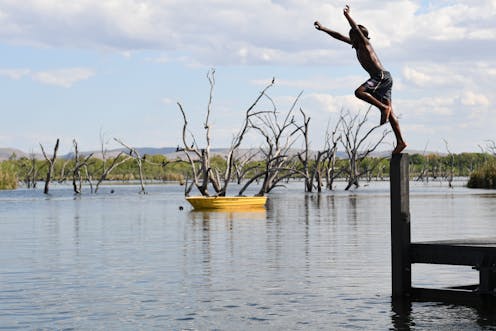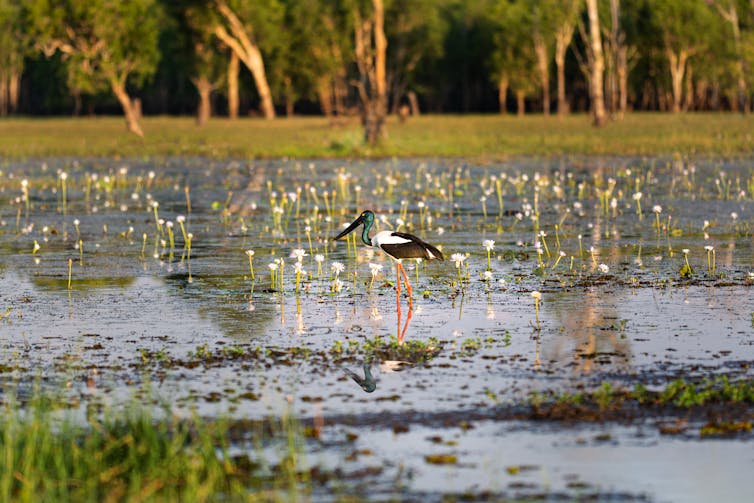
When the British colonised Australia they assumed terra nullius, “nobody’s land”, and aqua nullius, “nobody’s water”. In 1992, terra nullius was overturned – but aqua nullius remains.
Aqua nullius denies the existence of Indigenous peoples’ own water governance principles, laid down through ancestral “first laws”. These customary laws are carried through songlines, trade routes and ceremony, embedded in a deep reciprocal economy of sharing. First laws guide the custodianship of living waters, with attention to intergenerational equity.
Living waters – from rivers, to ancient aquifers to wetlands – are sacred and alive. As the source of energy to animate Country, living waters are critical to Indigenous Peoples’ collective survival. The responsibility of caring for waters (and land) are a central concern of Indigenous Peoples – but this responsibility is thwarted by aqua nullius.
Queensland, Northern Territory and Western Australia have sought to distribute water rights to Indigenous people by establishing “Indigenous (or Aboriginal) water reserves”, setting aside a portion of water from the consumptive pool for Indigenous people’s future use.
In our new policy brief, we unpack the benefits and limitations of these reserves. As it stands, the policy measure alone does not deliver justice for Indigenous peoples. A broader approach is needed.
The right to water
Indigenous people must be able to access water in their territories if they so choose.
A United Nations declaration recognises the right to water for Indigenous people. Yet First Nations water holdings in Australia and elsewhere are abysmally low. For example, Indigenous people or organisations hold less than 0.2% of surface water entitlements in the Murray Darling Basin.
In the struggle against aqua nullius, Indigenous people’s right to make decisions about water on Country is a priority. But importantly, when we talk about “water rights” for Indigenous people, the rights to access and use water is only one aspect.
The bigger picture problem is that the decision-making power over water remains with governments, and this power is not shared with Indigenous people.
We agree aqua nullius is unacceptable and must change. Establishing Indigenous water reserves is one option, but it’s far from clear it will deliver what Indigenous communities need.

Indigenous water reserves
The Northern Territory, Queensland and Western Australia have each introduced Indigenous water reserves into water allocation plans.
Water allocation plans define the consumptive pool – that is, how much water can be taken each year for consumptive purposes, such as for drinking supplies or irrigation.
There are at least 19 Indigenous water reserves across Northern Australia. This approach has not yet been adopted by other Australian states and territories.
Read more: Australia has an ugly legacy of denying water rights to Aboriginal people. Not much has changed
A major limitation of Indigenous water reserves is their narrow scope. In the NT and WA, their overall purpose is to provide economic opportunities for Indigenous people. Queensland reserves generally provide water to help Indigenous people achieve both economic and social aspirations.
A focus on using water for commercial purposes risks other crucial items – such as ensuring sufficient water for Country and to maintain ecosystem health – falling off the agenda, upholding the unacceptable status quo.
This is what Indigenous organisations have said repeatedly, and what our new policy brief reflects: that water for economic development is just one of many aspects to overcoming water injustice.
A market-based lens
There are two main reasons Indigenous water reserves should not be viewed solely through a market-based lens.
First, water in Indigenous reserves in the Northern Territory are only distributed when there is surplus water. The Central Land Council has stated:
in the majority of cases where the SAWRs [Strategic Aboriginal Water Reserves] should be available, the water resources have been fully or over-allocated and there is no water available for SAWR.
In other words, if there is no water surplus left, as determined by Australian governments, then the reserve is considered “notional”: in reality, non-existent.
Second, land tenure rules and regulations are being used to determine the allocation to Indigenous water reserves.
For example, in the Northern Territory, Indigenous holders of non-exclusive possession native title (that is, native title that co-exists with other forms of land tenure, such as a pastoral lease) are ineligible for water reserves.
This splits native title holders into those with water and those without, based on native title rules, creating an unfair division.
Arbitrary rules about who is eligible for Indigenous water reserves does not respond to the injustice of land and water stolen or forcibly acquired from Indigenous nations. In response to this failing, the Northern Land Council noted it:
has been disappointed that one of its key recommendations throughout the development of the [Aboriginal Water Reserve] was not adopted through the legislative amendment – that is, that eligibility should be broadened to encompass Aboriginal people and communities who have neither land rights nor exclusive native title.
Are there any benefits?
In contrast with top-down and arbitrary water allocation planning policies, water reserves can also be established through Indigenous land use agreements. A negotiated agreement between Indigenous groups and Australian governments, potentially has more scope to respond to past injustice and deliver meaningful benefits.
This is because it’s a negotiated settlement intended to be between partners, rather than a top-down “one size fits all” process for an entire state or territory.
Read more: Australia, it's time to talk about our water emergency
One possible example is the Yamatji Southern Regional Corporation (YSRC) lease of water to sand mining company Perpetual Resources in 2020. It is the first agreement between the WA government and an Indigenous nation to establish a negotiated access to water with an Indigenous Water Reserve.
Chief executive of YSRC, Jamie Strickland, has stated:
This agreement is the first of its kind and demonstrates how our Strategic Aboriginal Water Reserve can generate opportunities and economic benefits for the Yamatji Nation.
Missing details
An holistic approach is needed to ensure water rights support living waters, the environment, and spiritual and cultural connections. If Indigenous water reserves are to benefit Indigenous people, then governments must listen and negotiate in good faith with Indigenous nations.
When applied in water allocation plans, Indigenous water reserves must be part of a cohesive and comprehensive approach – one that delivers sovereignty for water to Indigenous nations and responds to the gross injustice and lie of aqua nullius.
Importantly, Indigenous water reserves need to be one part of a bigger-picture approach to water justice if aqua nullius is to be overturned.
The Water Justice Hub receives funding from the Australian Research Council Laureate Fellowship FL190100164.
Anne Poelina is the volunteer Chair with the Martuwarra Fitzroy River Council. She does not own, share or acquire any benefits from the Martuwarra Fitzroy River Council. She is the Managing Director (Volunteer) of Madjulla Inc. Indigenous Not for Profit Organisation based in the Kimberley, WA. She is also a member of the Aboriginal Water Group (AWG) advising the WA Department of Water and Environmental Regulations; a member of the Commonwealth Aboriginal Water Interest; and of the Murray Darling Basin (MDB) inaugural First Nations appointment to its independent Advisory Committee on Social, Economic and Environmental Sciences.
Quentin Grafton receives research funding from the Australian Research Council.
This article was originally published on The Conversation. Read the original article.







